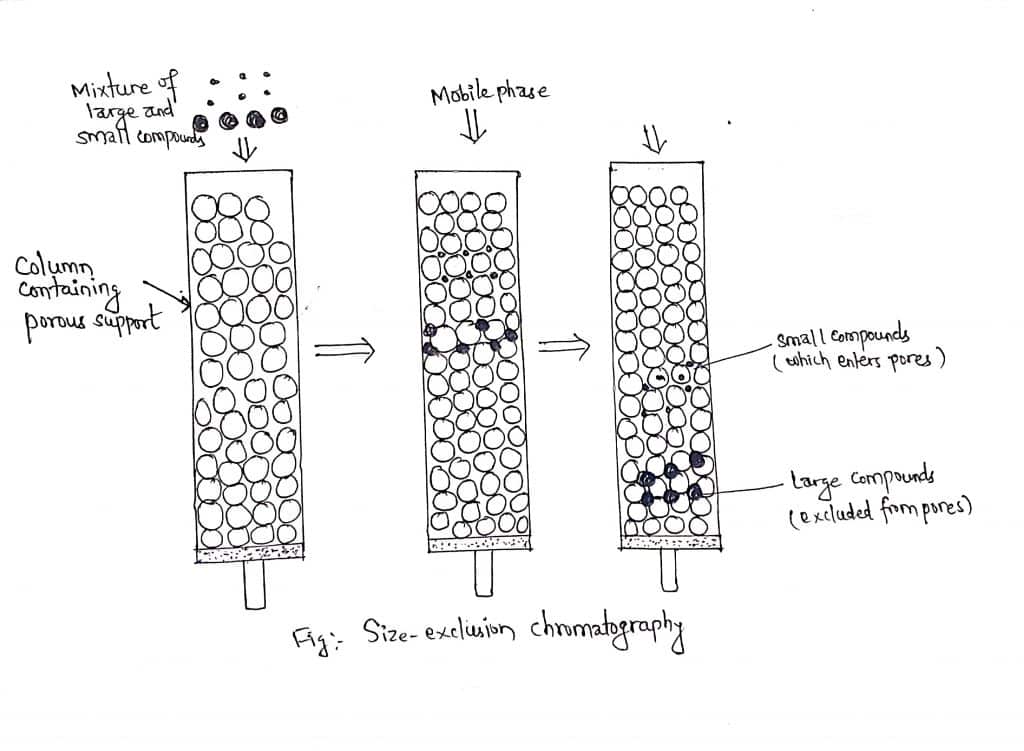Table of Contents
ToggleSize-exclusion chromatography is a type of chromatography in which separation is based on the molecular size and shape of species present in the sample. It is also known as “gel permeation chromatography”.
The term “gel permeation” is commonly used in polymer science for non-aqueous separations. SEC is defined as the differential elution of solutes, from a bed of a porous chromatographic medium, caused by different degrees of steric exclusion of sample molecules from the pore volume of the molecular size of solutes.
Theory of Size-exclusion chromatography
In size exclusion chromatography, the beads of porous polymeric materials act as a stationary phase{a gel}, and solution or liquid percolating through the beads acts as a mobile phase. The gel particles contain a distribution of pore sizes. Molecules of different sizes penetrate well-defined pores of column beads or gel, where they are retained at various degrees. Smaller molecules are retarded on the column, while larger ones are eluted more rapidly.
Thus in size exclusion chromatography, solutes are eluted strictly according to decreasing molecular size, and the maximum available volume for separation is equal to the total pore volume of the packing medium. The retention volume VR can be given by the following relation.

where KD= distribution coefficient i.e available pore fraction
VP= pore volume of packing medium
Vo= extra particle void volume

Factor affecting size-exclusion chromatography
The factors that affect separation in size exclusion chromatography are listed below:
- Column packing
- Column dimension
- Flow rate
- Sample volume
- Mobile phase composition
Sample volume and flow rate must be kept low for optimum resolution. Similarly, increasing column lengths improve resolution and which may be achieved by connecting columns in tandem.
Application of size-exclusion chromatography(SEC)
- It is widely used for the separation of natural polymers.
- SEC is now generally applied to the separation of molecules in the range between 0.5 and 1000 kDa, but larger proteins or other giant molecules can also be separated.
- The determination of molecular weight and molecular weight distribution of natural and synthetic polymers can be done by using SEC.
- SEC can also physically separate folded, from unfolded macromolecules.
- It is extensively used in the separation of biomolecules like sugars, polypeptides, proteins, lipids, etc.
Advantages of Size-exclusion chromatography
- It is simple and easy to operate.
- The gels can be reused after using once in chromatographic techniques
- Temperature change has very little effect on resolution.
- Since gel matrices do not undergo denaturation, they can be used in mild conditions.
- Short analysis time
- Good resolution and good sensitivity
Limitation of Size exclusion chromatography
- The components to be separated from the sample must have at least a 10% difference in molecular mass to have good resolution.
- A large number of bands can not be accommodated due to the short time scale of the chromatogram
- It is a moderately expensive technique
Size exclusion chromatography vs gel permeation chromatography
| Size exclusion chromatography | Gel permeation chromatography |
| It is a type of chromatography in which aqueous or organic solvent is used as a mobile phase. | It is a type of size exclusion chromatography in which organic solvent is used as a mobile phase. |
| It is applicable in the separation of polymers including biological, natural, and synthetic. | It is mainly used for the separation of natural and synthetic polymers. |
| It represents one type of chromatographic technique | it represents a subset of size exclusion chromatography. |
What elutes first in size exclusion chromatography?
Larger molecules with high molecular weight elute first in size exclusion chromatography.
What is size exclusion chromatography?
Size exclusion chromatography is a type of chromatography in which separation is based on the molecular size and shape of species present in the sample.






